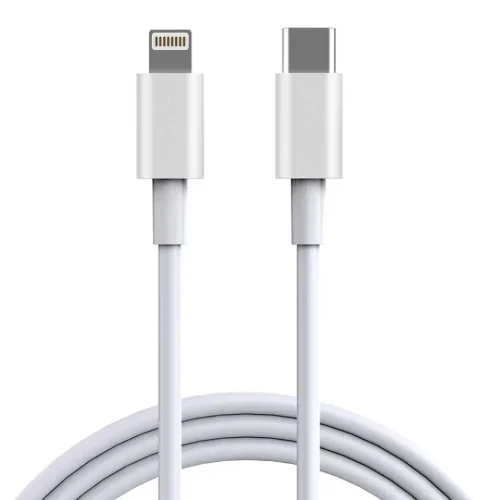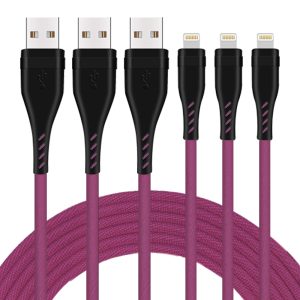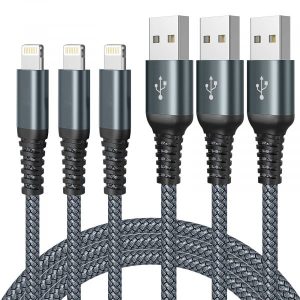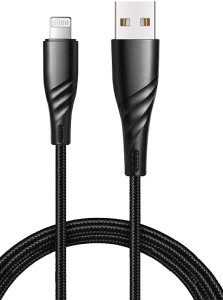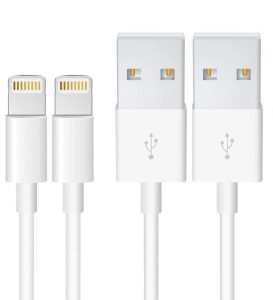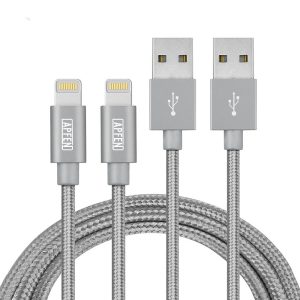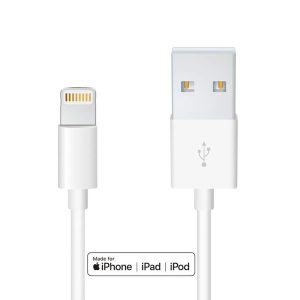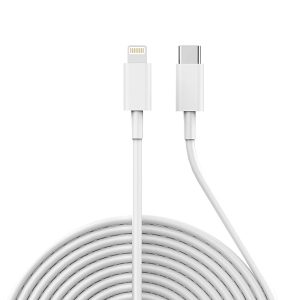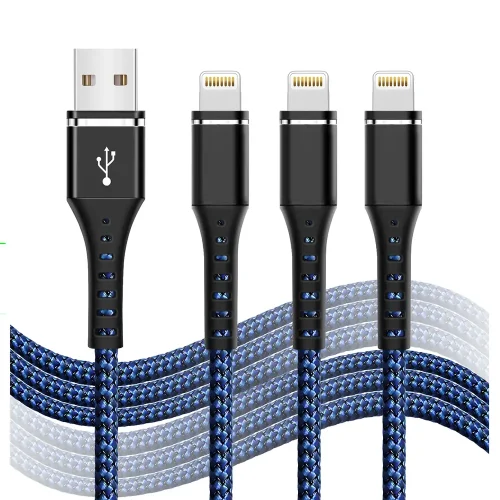
MFI cable manufacturer
The iPhone MFI Cable is an official Apple-certified accessory that ensures seamless compatibility and optimal performance with your Apple devices. As a leading manufacturer of Apple MFI cables, APPHONE prides itself on our capabilities, which sets us apart.
APPHONE is an MFI/CE/FCC/RoHS/REACH/ISO 9001 certified factory, ensuring that every cable meets Apple’s strict quality and reliability standards. Our diverse product range covers the latest specifications and models at the forefront of the market, including PD fast charging and C94 connectors. With a keen insight into industry trends, we provide customizable options such as logo, packaging and labels, so that your brand can gain better market effect.
Choose APPHONE, as your reliable Apple MFI cable supplier. Partner with an industry-leading iPhone MFI cable manufacturer to customize your iPhone MFI cable for a unique market advantage. We specialize in providing tailor-made solutions to meet your specific requirements. Our wholesale service makes it easy for you to source high-quality cables in bulk. Contact us today to discuss how to enhance your iPhone accessory offering.
Supported MFI chips
Different Apple chips support customizing different connectivity solutions.
Quality Certification
Comprehensive certification is to provide the best Apple Peripheral Cables like USB Lightning Cable, Lightning to 3.5mm Headphone Jack Adapter, Lightning to HDMI/VGA Adapter, Apple Lightning Digital AV Adapter, etc.
Of course, high-quality and reliable products are inseparable from the quality control measures we follow at all times. Strict production processes ensure that products always meet the highest quality requirements.



Customized MFI cable solution
Custom Logo Printing for MFI Cables
Within our factory premises, a dedicated laser engraving studio is established. Multiple high-precision laser engraving machines assist clients in imprinting logos onto MFI cables. This service ensures brand consistency and enhances promotional efforts.
Tailored Cable Lengths for MFI Cables
Our produced MFI data cables come with fully customizable lengths, accommodating any required specifications. Whether you need a longer or shorter cable, APPHONE can accommodate your needs, with standard stock lengths including 100cm, 120cm, and 150cm.
Vivid Color Customization for MFI Cables
MFI cable colors, akin to their lengths, are entirely customizable. Share your Pantone color code with us and we will exclusively use your color for Apple MFI cable production. Moreover, diverse color-braided cables are supported, albeit at a slightly higher unit cost.
Diverse Material Utilization for MFI Cables
Throughout the iphone MFI data cables manufacturing process, an array of materials is employed. Cable components include TPE, PVC, alloy braiding, and silicone; outer casings encompass metal conduits, leather, ABS shells, and textured weaving. All materials adhere to Reach/ROHS environmental standards. For custom materials, please feel free to contact APPHONE.
Multiple Port Shapes for MFI Cables
APPHONE offers a variety of standard port shapes for selection. Additionally, our workshop houses multiple integrated injection molding machines, facilitating customized mold creation as per your requirements. Port casings can be optionally equipped with ABS, aluminum alloy, or zinc alloy.
Personalized Packaging Options for MFI Cables
We extend customized packaging design and material selection for all clients. Choices encompass OPP bags, versatile combination packages, eco-friendly paper tube packaging, plastic boxes, and creative color boxes, catering to diverse retail channels and brand aesthetics.
About APPHONE
Since APPHONE obtained MFI certification in 2016, it has continued to cultivate the cable field. Has become an international professional MFI certified iphone cable manufacturer, strict quality control measures to create high-quality electronic products for customers.
Long-term commitment to technological innovation, at this stage has: Apple Lightning data cable, USB Type C data cable, Micro data cable, earphones, adapters, wall chargers, car chargers and other one-stop production lines. Adhere to customer-centric, create a better future.
Reliable Strength and Complete Quality Control System
Appphone as a one-stop custom MFI manufacturer. The production line is well-equipped to provide processing, injection molding, printing, assembly, quality control, packaging and shipping services. We have a large workshop of 4000㎡ and more than 200 experienced workers. From material inspection, soldering to finished product packaging, manual and machine cooperation, every step is in order. Ensure high quality, reliability and durability of products. Sustained and steady operation and development have made us a popular manufacturer supplier for large and medium-sized data line companies in the world.
Complete and reliable certification system
Experience trusted connections with our certified products. From Apple Lightning cables to USB Type C cables, Micro USB cables, audio headsets, adapters and chargers, we provide a range of B2B solutions and are approved by Apple MFI, USB, RoHS, CE, FCC, REACH, UL and ISO certification. Capable and confident to complete the production of various electronic products.
International Trade Shows: B2B Distribution
We have proudly showcased our products at numerous global trade shows, including CES in Las Vegas, the Hong Kong Exhibition, CeBIT in Hannover, and MEGE SHOW in Paris. Our offerings have garnered recognition from brands and customers worldwide. Renowned brands have forged strong partnerships with us, with our factory’s products available at major retailers like Wal-Mart, Target, Best Buy, 7-Eleven, and Rakuten. Additionally, we hold the distinction of being a gold supplier of USB cables on Alibaba. Your visit is warmly invited, promising superior quality, competitive pricing, and unparalleled service.
We‘d Like to Hear From You
- Tel: 86-755-29652035
- Fax:86-755-28231235
- Email: admin@szapphone.com
- Address: 6/F, A Building, ZhengChangDa Technology Park, JianAn Road,Fuyong Town, BaoAn District, Shenzhen 518000 China
Getin touch with apphone
Apple MFI cable FAQ
What is MFI certification?
MFI certification (Made for iPhone/iPad/iPod) is a certification officially granted by Apple, which ensures the high compatibility and stability of the data cable with Apple devices. By obtaining MFI certification, the data cable can seamlessly connect and work with Apple devices.
What are the advantages of MFI cable?
Compared with ordinary data cables, MFI data cable has many advantages, including stable charging and data transmission performance, fast charging support, security guarantee, and seamless cooperation with native functions of Apple devices. In order to meet Apple’s iPhone, iPod, iPad and other products performance standards.
How to confirm whether a data cable is MFI certified?
You can look for the “MFI” mark on the data cable package or verify it through official channels. A data cable that is not MFI-certified will display the prompt “This accessory may not be supported” when connecting to an Apple device.
Why should you choose MFI cable?
Choosing MFI cable can avoid charging errors, extend the life of the device, and ensure that the data cable used meets the high standards of Apple devices to ensure safety and performance.
Does MFI cable support fast charge?
Yes, MFI cable usually supports fast charging function, which can achieve faster charging speed when used with Apple’s official charger.
Why choose APPHONE's Apple MFI data cable?
As a reliable manufacturer, APPHONE provides high-quality Apple MFI data cable with MFI certification, and also provides customized production services to meet individual needs.
What are the customization options for MFI cable?
APPHONE provides a variety of customization options, such as: packaging, logo logo, length, color, material, etc., to meet the needs of different customers.
How is the certification of MFI cable carried out?
MFI certification is a strict process conducted by Apple officials. Manufacturers need to meet a series of requirements and pass tests to ensure the compatibility, performance and safety of data cables when connected to Apple devices. MFi’s certification pass rate is only 2%. As an MFI certified manufacturer, APPHONE has passed these audits and tests to ensure that our MFI data cables meet the highest standards.
How to maintain and use MFI cable?
It is recommended to avoid excessive bending and pulling of the data cable, clean the connection port regularly, and avoid overcharging. These measures help to maintain the performance and life of the MFI cable.
What is the market prospect of MFI cable?
The market prospect of MFI cable depends on Apple. It can be said that as long as Apple exists, the MFI data cable is a must. Especially at the moment when consumer demand for mobile devices and wearable devices continues to grow, the future market prospects are very optimistic.
| MFI Vs. Non-MFI Cables | |||
|---|---|---|---|
| Features | MFI | APFEN-Chip | Non-MFI |
| Smart Chip | Apple Certified | Byte 6 Chips | No-chip |
| Charging | Support | Support | Support |
| Datasync | Support | Support | No |
| Stability | High Quality | High Quality | General |
| Price | Expensive | Affordable | Cheap |
| Warranty | Lifetime | 12 Months | No |
| Compatible | All iOS Version | All iOS Version | NOT |

Fast delivery
Fastest delivery within 22 days

Quick proofing
Fastest 3-day proofing cycle

After-sale protection
24-month long warranty

1V1Customer Service
Professional customer service follow-up

